Is Banning Fossil-Fueled Internal Combustion Engines the First Step in a Realistic Transition to a 100% RES Share?
Abstract
1. Introduction
- In the unavoidable energy transition towards a 100% renewable scenario, when is it most convenient to decarbonize the LDVs?
- What kind of LDV decarbonizing solution is most appropriate to minimize the overall decarbonization cost for society?
- How cost-effective is it to ban fossil-fueled light commercial vehicles by 2035?
2. Materials and Methods
2.1. The National Energy System Model
2.1.1. General Framework, Units, Infrastructures, Inputs and Outputs
2.1.2. Modeling Approaches for Electric and E-Fuel Vehicles
- Recycling cost of batteries.
- Deployment cost of batteries.
- Change in social habits (i.e., reduction in consumption for transportation). In fact, the reduction in energy consumption could be a disadvantage for the utilization of EVs since the benefits of the scale effect on all technology costs would be lost.
2.1.3. Equations
- 1.
- Equation for the energy conversion units:
- 2.
- Equation for the energy storage units:
- 3.
- Equations for the gas grid:
2.2. Simulation Criteria
2.2.1. Optimization Method
2.2.2. Trend of the Costs
2.2.3. Optimization Scenarios
- “Free” optimization scenario. In this case, the series of optimizations is carried out considering no additional constraints to those given in Section 2.2.1. Accordingly, the result of this optimization process is the most cost-effective energy transition scenario.
- 2035 policy scenario—“e-fuel”. The ban of fossil-fueled LDVs is included as an additional constraint. From 2035 the model is forced to decarbonize the LDVs consumptions by choosing either full-electric or internal combustion engines LDVs fed by e-fuels produced from renewables.
- 2035 policy scenario—“pure electric”. This scenario differs from the previous one for the additional constraint imposing after 2035 only electric technology to decarbonize the LDV sector.
- 2035 policy scenario—“e-fuel pessimistic”. The scenario 2 is replicated considering a pessimistic trend of the future cost projection for the e-fuels.
3. Results and Discussion
4. Conclusions
- The light duty transportation sector is cost-effective to decarbonize in the later stages of the transition, between 90% and 100% of renewable energy share. Combustion engine vehicles fueled by e-fuels are the less expensive choice considering current cost projections, both in the base case and in the pessimistic one.
- The policy of banning fossil-fueled internal combustion vehicles starting from 2035 would increase the transition costs by 20% (considering e-fuel vehicles) to 60% (considering electric vehicles) between 2035 and 2090.
- With the implementation of European policies related to 2035, the use of e-fuels is more cost-effective than the use of battery electric vehicles. In the case of a particularly pessimistic scenario for e-fuels (+40% of predicted costs), the cost of the energy transition in which the use of electric vehicles is imposed would still be 5% higher. This gap increases up to 30% in the case of the most likely cost scenario for e-fuels.
- The main disadvantage of battery electric vehicles lies in the method of energy supply. The timing required for battery charging causes the need for larger extensions of the electric grid and for larger electric storage capacities than those required in the case of e-fuels. The indirect costs make electric vehicles inconvenient even though the direct costs are markedly lower than the other available options.
Author Contributions
Funding
Data Availability Statement
Conflicts of Interest
References
- Jain, P.C. Greenhouse effect and climate change: Scientific basis and overview. Renew. Energy 1993, 3, 403–420. [Google Scholar] [CrossRef]
- EEA. Climate Change Mitigation Policies and Measures. Available online: https://www.eea.europa.eu/data-and-maps/data/climate-change-mitigation-policies-and-measures-1 (accessed on 1 January 2020).
- International Energy Agency. World Energy Outlook 2022; IEA: Paris, France, 2022; Available online: https://www.iea.org/reports/world-energy-outlook-2022 (accessed on 23 April 2023).
- Cracknell, R.; Ciatti, S.; Dorofeev, S.; Eggels, R.; McManus, K.; Nakata, K. Decarbonization of mobility, including transportation and renewable fuels. Proc. Combust. Inst. 2023, 39, 1–9. [Google Scholar] [CrossRef]
- European Environment Agency. Transport and Environment Report 2021. Decarbonising Road Transport—The Role of Vehicles, Fuels and Transport Demand; Report No 02/2022; European Environment Agency: Copenhagen, Denmark, 2021. [Google Scholar]
- Egbue, O.; Long, S. Barriers to widespread adoption of electric vehicles: An analysis of consumer attitudes and perceptions. Energy Policy 2012, 48, 717–729. [Google Scholar] [CrossRef]
- Slowik, P.; Isenstadt, A.; Pierce, L.; Searle, S. Assessment of Light-Duty Electric Vehicle Costs and Consumer Benefits in the United States in the 2022–2035 Time Frame. International Council on Clean Transportation: Washington, DC, USA, 2022. [Google Scholar]
- Palacin, M.R. Recent advances in rechargeable battery materials: A chemist’s perspective. Chem. Soc. Rev. 2009, 38, 2565–2575. [Google Scholar] [CrossRef]
- Rivera, S.; Kouro, S.; Vazquez, S.; Goetz, S.M.; Lizana, R.; Romero-Cadaval, E. Electric vehicle charging infrastructure: From grid to battery. IEEE Ind. Electron. Mag. 2021, 15, 37–51. [Google Scholar] [CrossRef]
- Mueller, S.; Rohr, S.; Schmid, W.; Lienkamp, M. Analysing the Influence of Driver Behaviour and Tuning Measures on Battery Aging and Residual Value of Electric Vehicles. In Proceedings of the EVS30 International Battery, Hybrid and Fuel Cell Electric Vehicle Symposium, Stuttgart, Germany, 9–11 October 2017. [Google Scholar]
- Jaguemont, J.; Boulon, L.; Dubé, Y. A comprehensive review of lithium-ion batteries used in hybrid and electric vehicles at cold temperatures. Appl. Energy 2016, 164, 99–114. [Google Scholar] [CrossRef]
- Roy, J.J.; Cao, B.; Madhavi, S. A review on the recycling of spent lithium-ion batteries (LIBs) by the bioleaching approach. Chemosphere 2021, 282, 130944. [Google Scholar] [CrossRef]
- Secinaro, S.; Calandra, D.; Lanzalonga, F.; Ferraris, A. Electric vehicles’ consumer behaviors: Mapping the field and providing a research agenda. J. Bus. Res. 2022, 150, 399–416. [Google Scholar] [CrossRef]
- Santos, N.D.; Roso, V.R.; Malaquias, A.C.; Baêta, J.C. Internal combustion engines and biofuels: Examining why this robust combination should not be ignored for future sustainable transportation. Renew. Sustain. Energy Rev. 2021, 148, 111292. [Google Scholar]
- Mahapatra, S.; Kumar, D.; Singh, B.; Sachan, P.K. Biofuels and their sources of production: A review on cleaner sustainable alternative against conventional fuel, in the framework of the food and energy nexus. Energy Nexus 2021, 4, 100036. [Google Scholar] [CrossRef]
- Delucchi, M.A. Impacts of biofuels on climate change, water use, and land use. Ann. N.Y. Acad. Sci. 2010, 1195, 28–45. [Google Scholar] [CrossRef] [PubMed]
- Subramaniam, Y.; Masron, T.A.; Azman, N.H.N. The impact of biofuels on food security. Int. Econ. 2019, 160, 72–83. [Google Scholar] [CrossRef]
- Simmons, B.A.; Loque, D.; Blanch, H.W. Next-generation biomass feedstocks for biofuel production. Genome Biol. 2008, 9, 242. [Google Scholar] [CrossRef]
- Dharma, S.; Ong, H.C.; Masjuki, H.H.; Sebayang, A.H.; Silitonga, A.S. An overview of engine durability and compatibility using biodiesel–bioethanol–diesel blends in compression-ignition engines. Energy Convers. Manag. 2016, 128, 66–81. [Google Scholar] [CrossRef]
- Mena-Cervantes, V.Y.; Hernández-Altamirano, R.; García-Solares, S.M.; Arreola-Valerio, E. Biodiesel in circular economy. In Biofuels in Circular Economy; Springer Nature Singapore: Singapore, 2023; pp. 251–278. [Google Scholar]
- Das, S. The National Policy of biofuels of India–A perspective. Energy Policy 2020, 143, 111595. [Google Scholar] [CrossRef]
- Ausfelder, F.; Wagemann, K. Power-to-fuels: E-fuels as an important option for a climate-friendly mobility of the future. Chem. Ing. Tech. 2020, 92, 21–30. [Google Scholar] [CrossRef]
- Marcolongo, D.M.; Aresta, M.; Dibenedetto, A. Stepping toward the carbon circular economy (CCE): Integration of solar chemistry and biosystems for an effective CO2 conversion into added value chemicals and fuels. Adv. Inorg. Chem. 2021, 78, 289–351. [Google Scholar]
- Viscardi, R.; Bassano, C.; Nigliaccio, G.; Deiana, P. The potential of E-fuels as future fuels. ENEA Energ. Ambiente Innov. 2021, 1, 112–116. [Google Scholar]
- Zhong, J.; Bollen, M.; Ronnberg, S. Towards a 100% renewable energy electricity generation system in Sweden. Renew. Energy 2021, 171, 812–824. [Google Scholar] [CrossRef]
- Hrncic, B.; Pfeifer, A.; Juric, F.; Duic, N.; Ivanovic, V.; Vusanovic, I. Different investment dynamics in energy transition towards a 100% renewable energy system. Energy 2021, 237, 121526. [Google Scholar] [CrossRef]
- Song, S.; Li, T.; Liu, P.; Li, Z. The transition pathway of energy supply systems towards carbon neutrality based on a multi-regional energy infrastructure planning approach: A case study of China. Energy 2022, 238, 122037. [Google Scholar] [CrossRef]
- Bogdanov, D.; Gulagi, A.; Fasihi, M.; Breyer, C. Full energy sector transition towards 100% renewable energy supply: Integrating power, heat, transport and industry sectors including desalination. Appl. Energy 2021, 283, 116273. [Google Scholar] [CrossRef]
- Kalghatgi, G. Is it really the end of internal combustion engines and petroleum in transport? Appl. Energy 2018, 225, 965–974. [Google Scholar] [CrossRef]
- Danieli, P.; Lazzaretto, A.; Al-Zaili, J.; Sayma, A.; Masi, M.; Carraro, G. The potential of the natural gas grid to accommodate hydrogen as an energy vector in transition towards a fully renewable energy system. Appl. Energy 2022, 313, 118843. [Google Scholar] [CrossRef]
- Brynolf, S.; Taljegard, M.; Grahn, M.; Hansson, J. Electrofuels for the transport sector: A review of production costs. Renew. Sustain. Energy Rev. 2018, 81, 1887–1905. [Google Scholar] [CrossRef]
- Rech, S. Smart Energy Systems: Guidelines for Modelling and Optimizing a Fleet of Units of Different Configurations. Energies 2019, 12, 1320. [Google Scholar] [CrossRef]
- Gabrielli, P.; Gazzani, M.; Martelli, E.; Mazzotti, M. Optimal design of multi-energy systems with seasonal storage. Appl. Energy 2018, 219, 408–424. [Google Scholar] [CrossRef]
- Vellini, M.; Bellocchi, S.; Gambini, M.; Manno, M.; Stilo, T. Impact and costs of proposed scenarios for power sector decarbonisation: An Italian case study. J. Clean. Prod. 2020, 274, 123667. [Google Scholar] [CrossRef]
- Directorate-General for Energy (European Commission). Cost of Energy (LCOE)—Energy Costs, Taxes and the Impact of Government Interventions on Investments: Final Report. 2020. Available online: https://op.europa.eu/en/publication-detail/-/publication/e2783d72-1752-11eb-b57e-01aa75ed71a1 (accessed on 23 April 2023).
- Danish Energy Agency and Energinet. Technology Data—Energy Plants for Electricity and District Heating Generation. First published August 2016. Available online: http://www.ens.dk/teknologikatalog (accessed on 23 April 2023).
- International Energy Agency. The Future of Hydrogen; International Energy Agency: Paris, France, 2019; Available online: https://www.iea.org/reports/the-future-of-hydrogen (accessed on 23 April 2023).
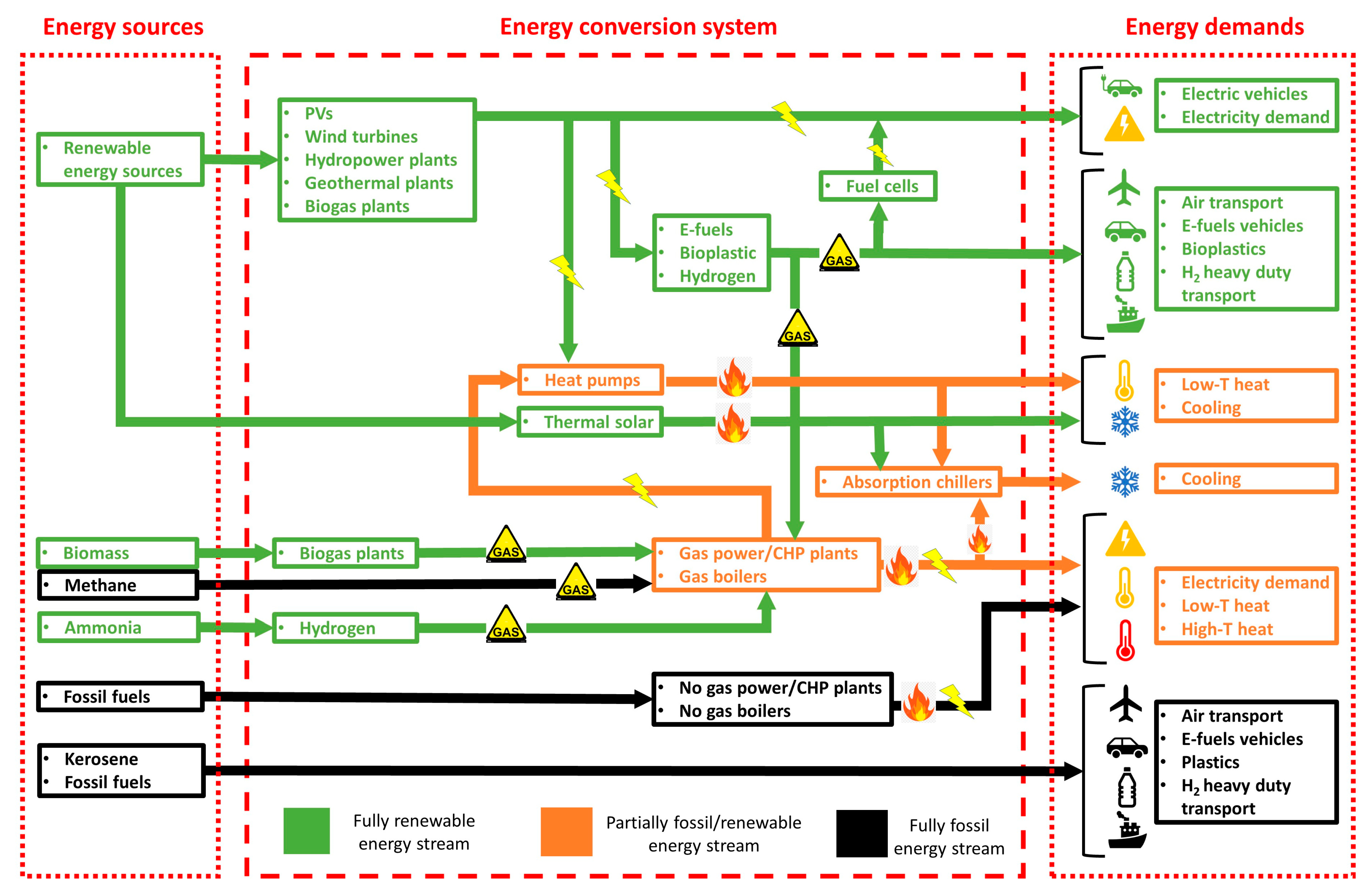


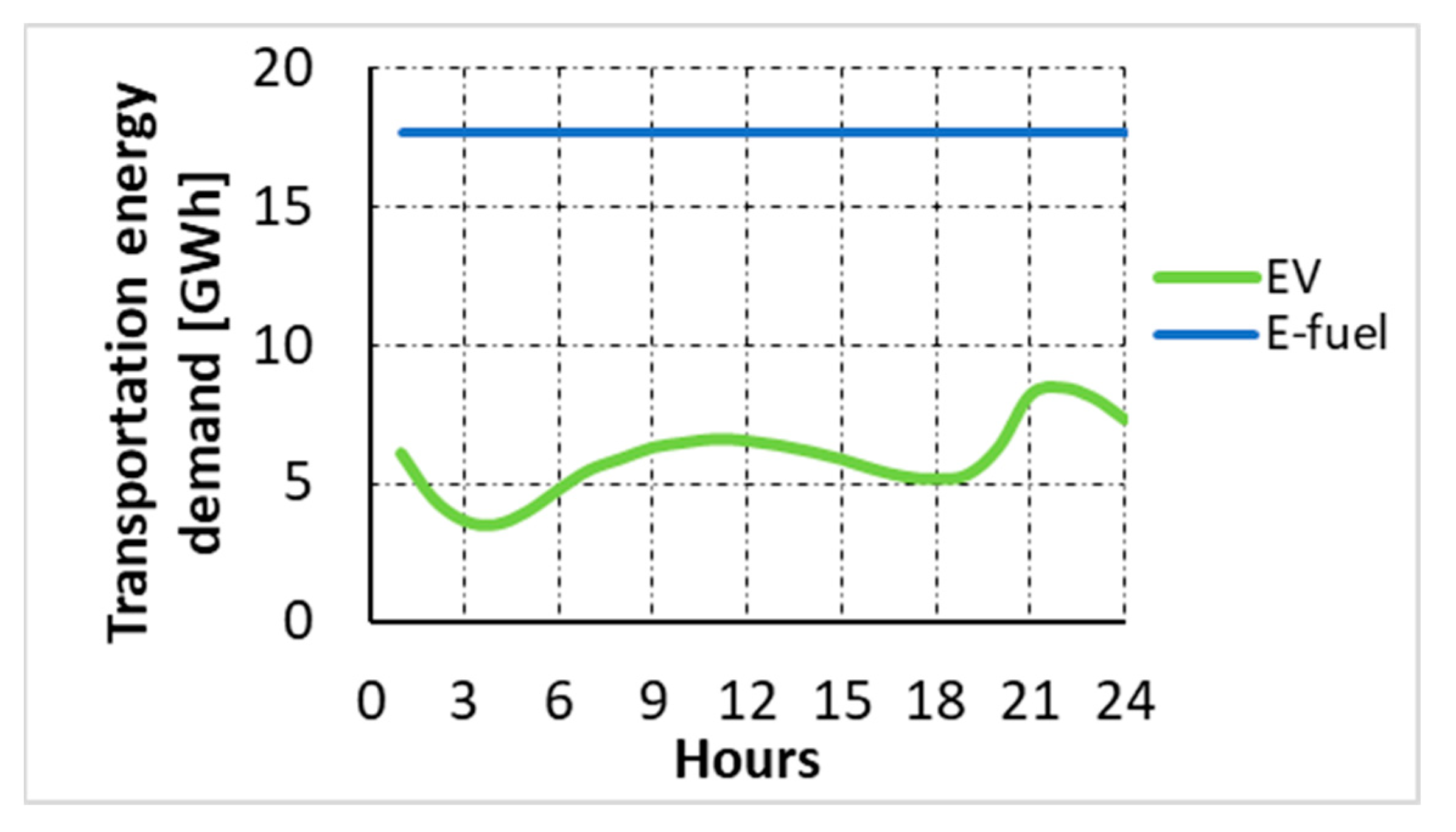
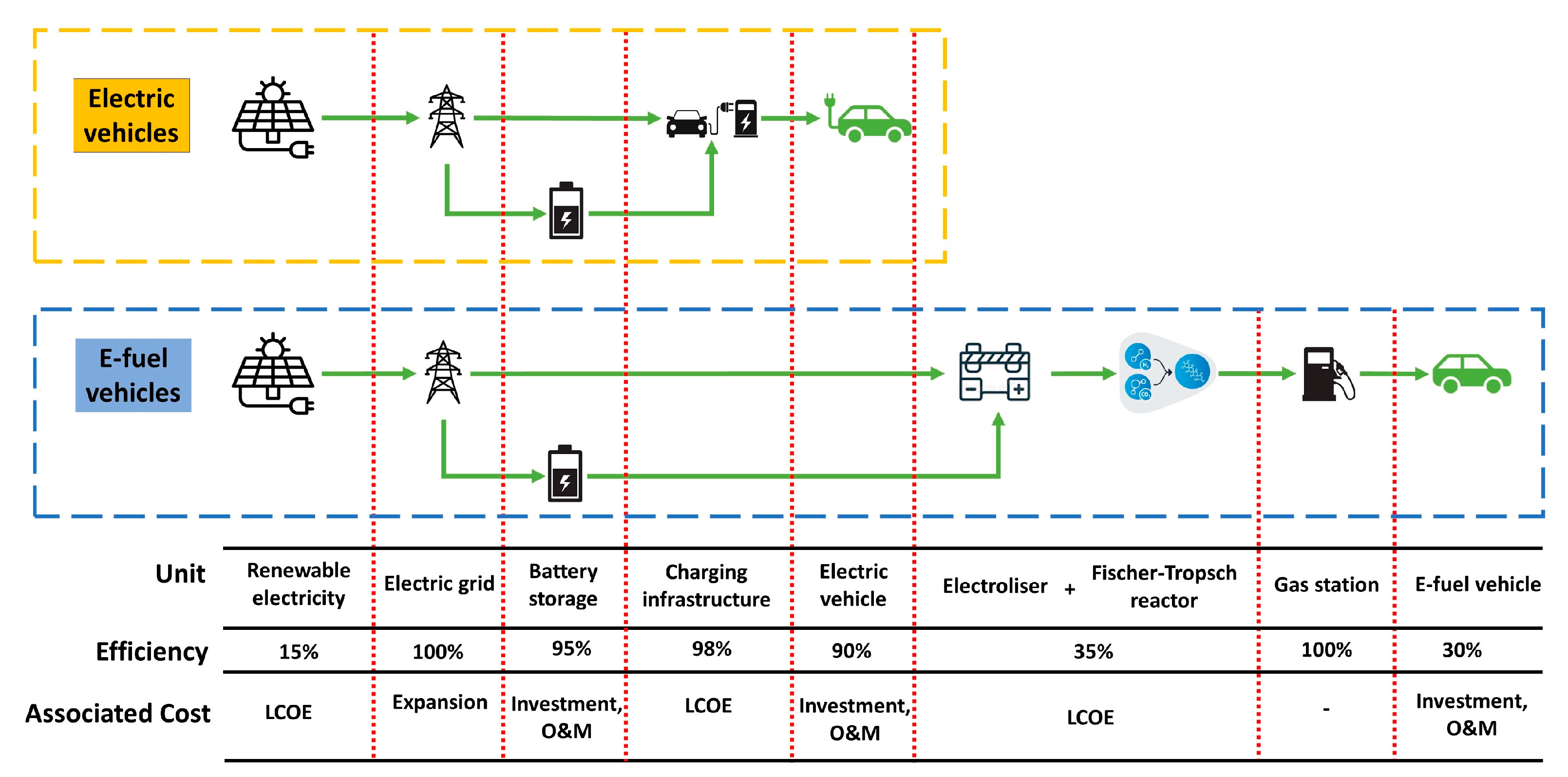
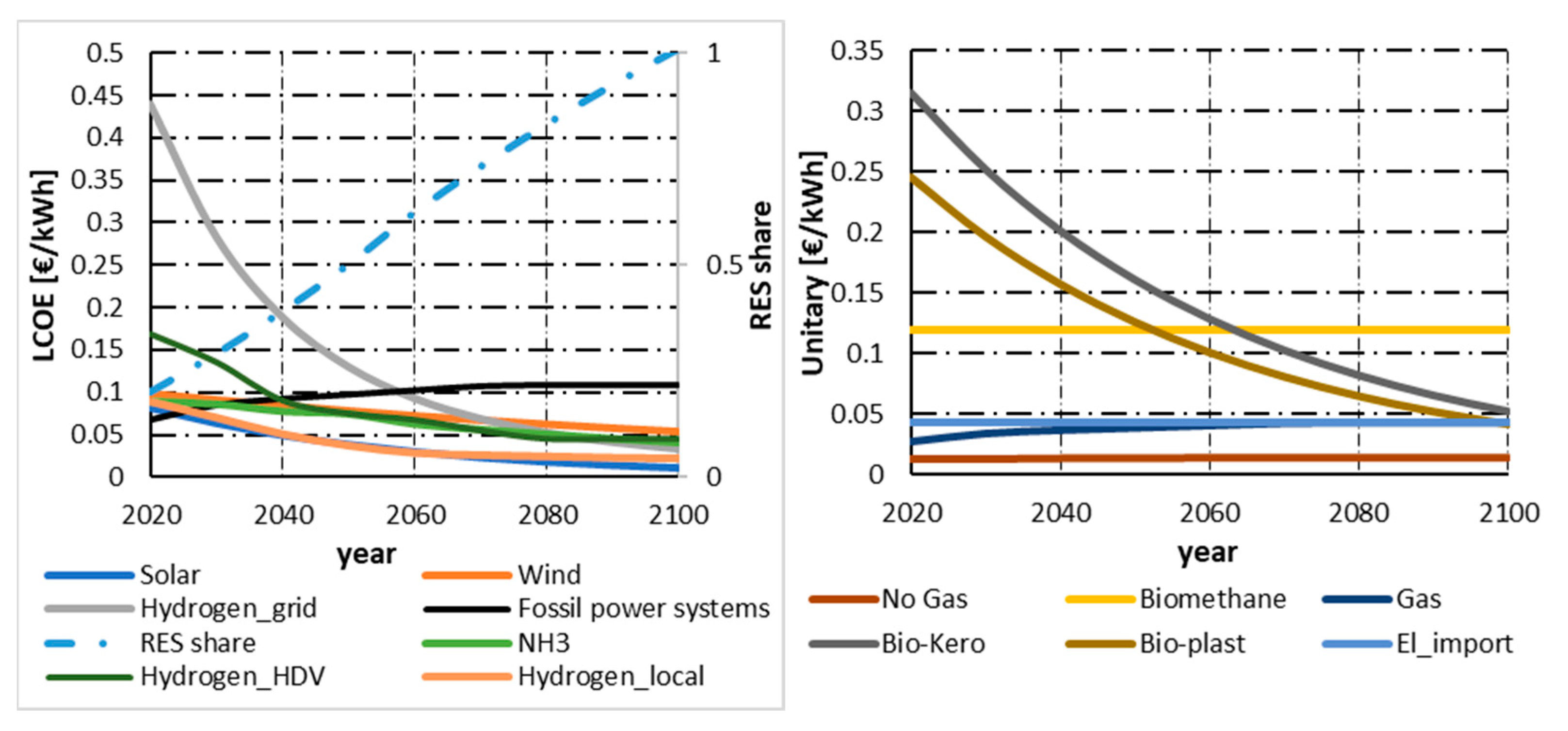

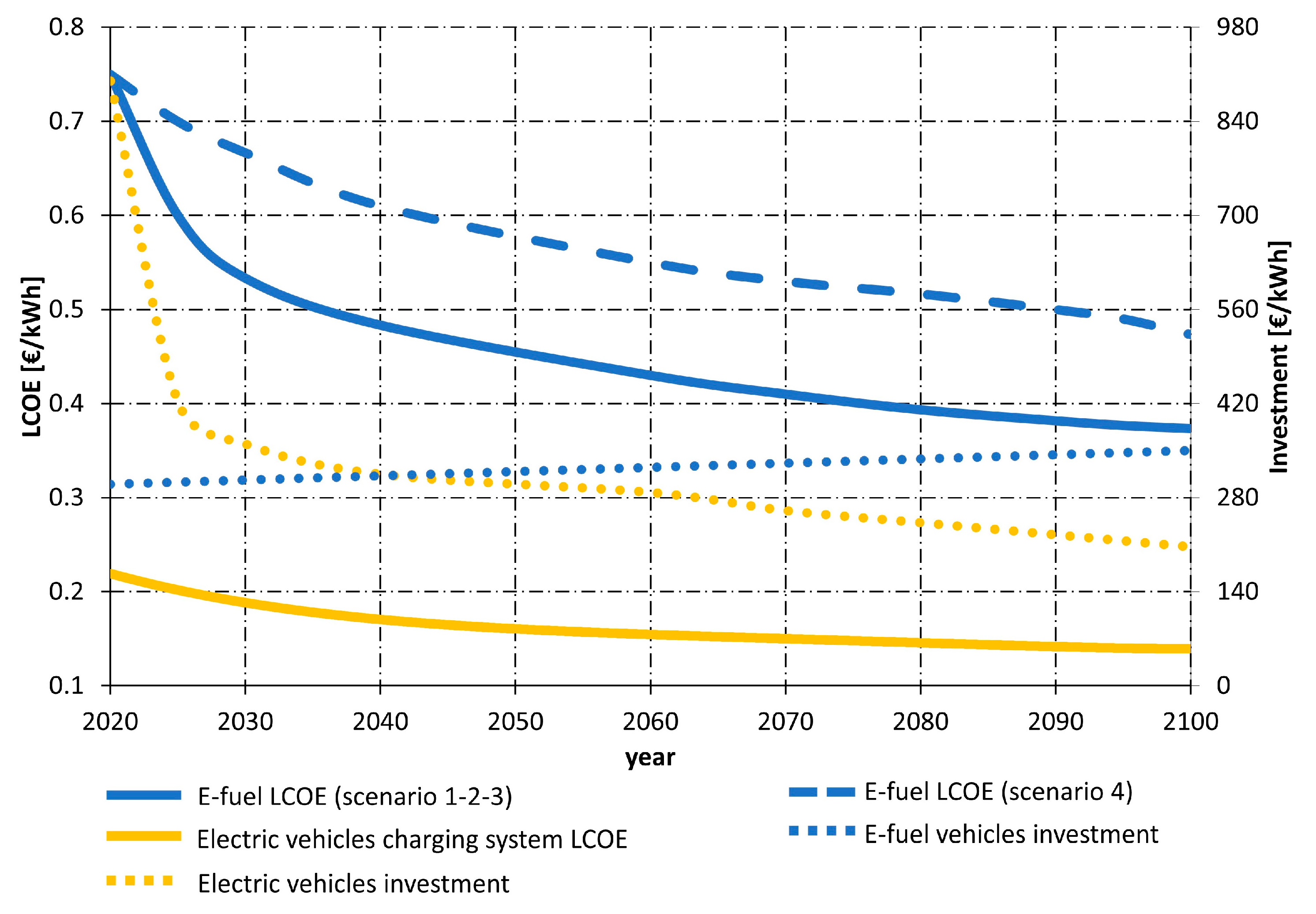
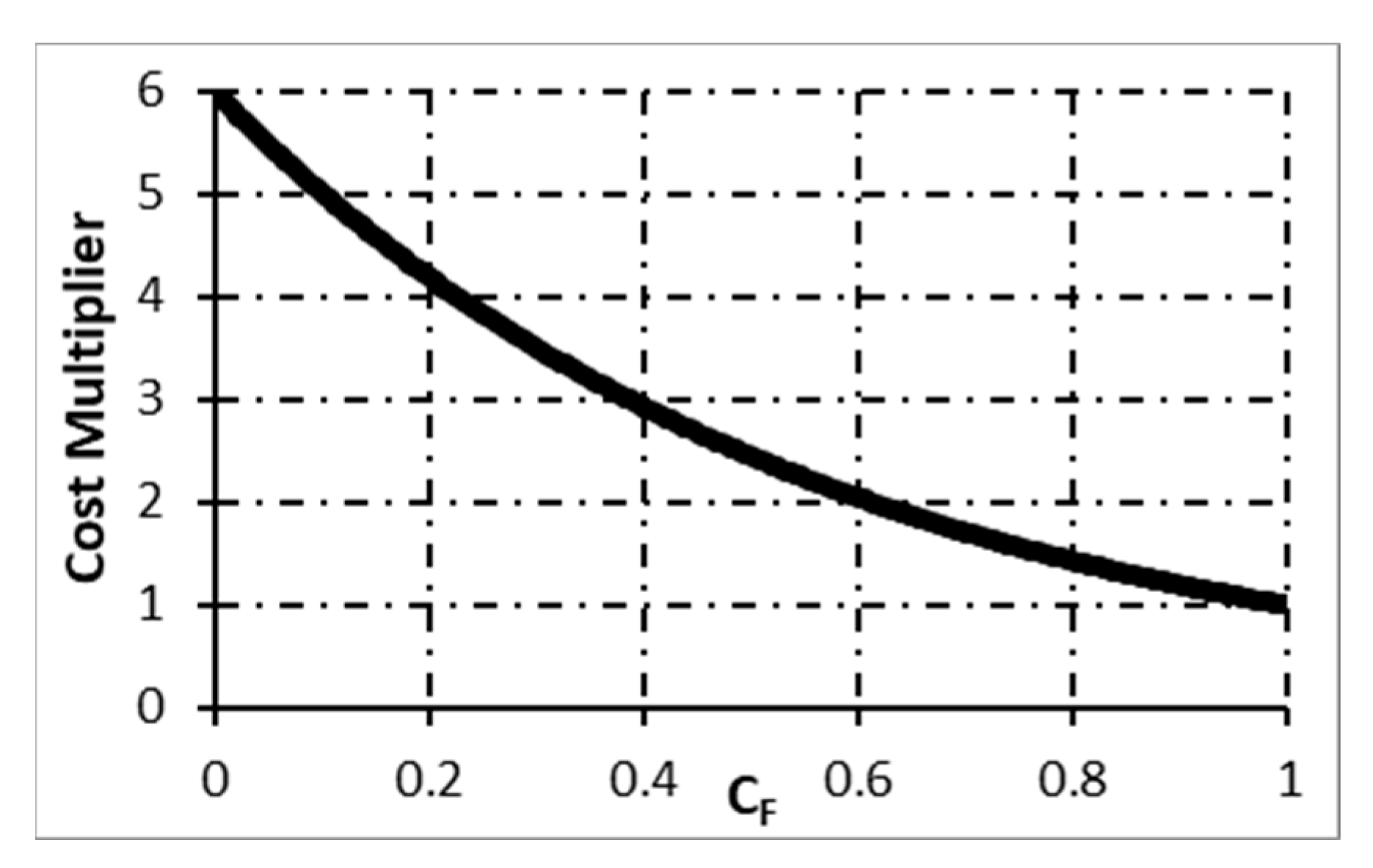


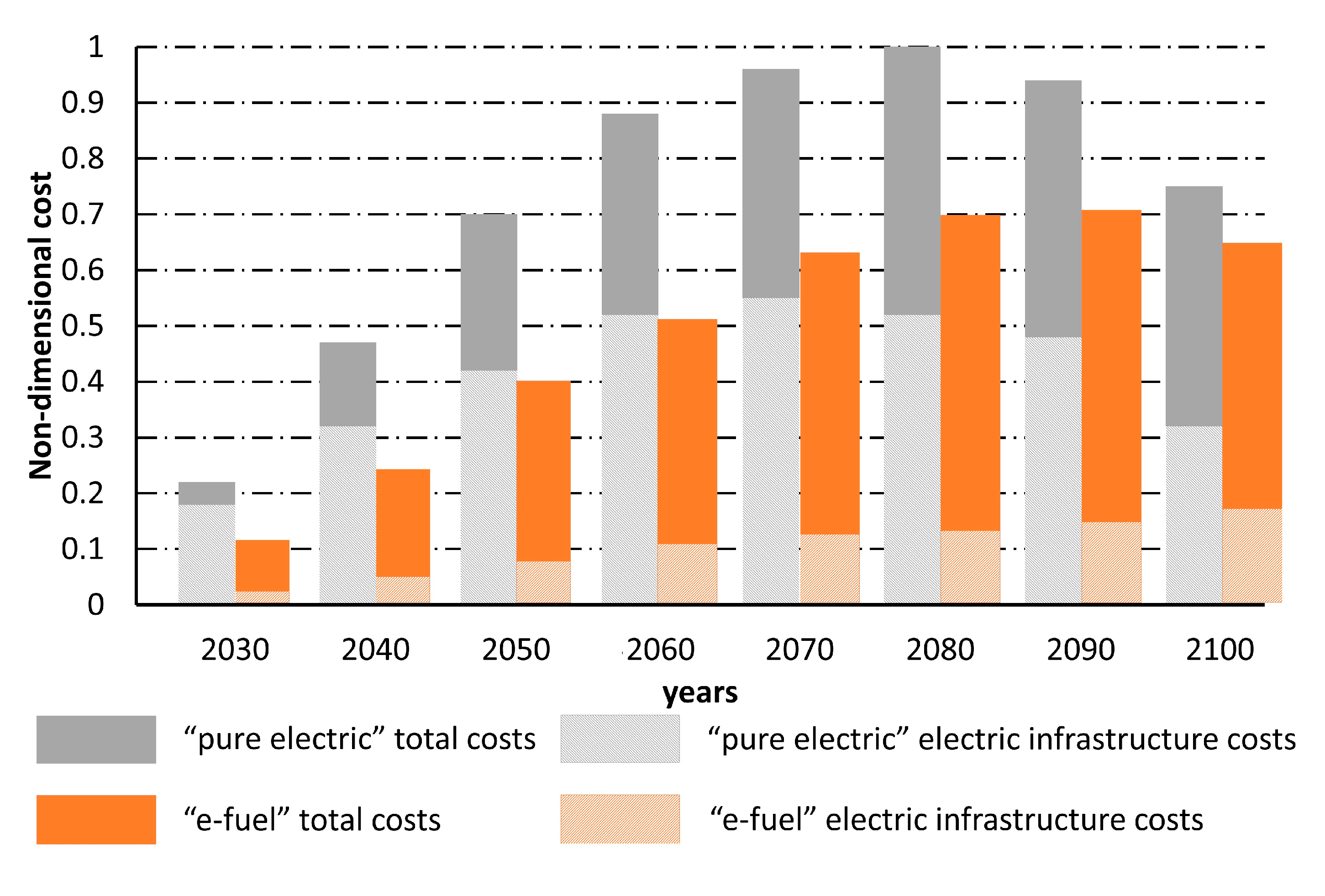
| Energy Conversion Units | Energy Storage Systems | Energy Transport Infrastructures | Energy Sources | Energy Demands |
|---|---|---|---|---|
| Photovoltaics | Electric | Electric grid | Solar | Electricity |
| Thermal solar | Heat | Gas grid | Wind | Low-T Heat |
| Wind turbines | Cooling | Thermal grid | Geothermal | High-T Heat |
| Geothermal plants | Hydrogen | Hydro-power | LDVs | |
| Hydro-power plants | Bio-mass | HDVs | ||
| Bio-methane plants | Ammonia | Aviation | ||
| Fuel cells | Methane | Plastics | ||
| Electrolyzers | Fossil fuels | Cooling | ||
| Fisher–Tropsch reactors | Marine | |||
| Ammonia reactors | ||||
| Gas power plants | ||||
| Gas CHP plants | ||||
| No-gas power plants | ||||
| No-gas CHP plants | ||||
| Gas boilers | ||||
| No-gas boilers | ||||
| Domestic heat pumps | ||||
| Centralized heat pumps | ||||
| Absorption chillers |
| Technology/Fuel | Type of Cost | Unit |
|---|---|---|
| Gas | unitary | €/kWh |
| Bio-gas | unitary | €/kWh |
| Fossil fuel other than gas | unitary | €/kWh |
| Imported electricity | unitary | €/kWh |
| Electricity for electric LDVs | unitary | €/kWh |
| Fossil-power plants | LCOE | €/kWhel |
| Imported hydrogen | LCOH | €/kWh |
| Bio-kerosene | LCOK | €/kWh |
| Bio-plastic | LCOP | €/kWh |
| PV | LCOE | €/kWhel |
| Wind | LCOE | €/kWhel |
| PEM (gas grid injection of H2) | LCOH | €/kWh |
| H2 for heavy-duty transportation | LCOH | €/kWh |
| H2 as fuel for gas power plants | LCOH | €/kWh |
| Charging infrastructure for electric LDVs | LCOE | €/kWh |
| Electricity for e-fuel conversion units | LCOE | €/kWh |
| Centralized heat pumps | Investment | €/kWth |
| Domestic heat pumps | Investment | €/kWth |
| Electric grid expansion | Investment | €/kW |
| Gas heat pumps | Investment | €/kW |
| Thermal storage | Investment | €/kWh |
| Electric storage (stationary) | Investment | €/kWh |
| Electric vehicles | Investment | €/kWh |
| E-fuel vehicles | Investment | €/kWh |
| Gas power plants | Investment | €/kW |
| Combined-cycle gas power plants | Investment | €/kW |
| No-Gas power plants | Investment | €/kW |
| No-Gas cogeneration power plants | Investment | €/kW |
| Absorption systems | Investment | €/kW |
| Thermal solar collectors (utility scale) | Investment | €/m2 |
| Fuel cells (stationary) | Investment | €/kWel |
| Fuel cells (automotive) | Investment | €/kWel |
| H2 storage | Investment | €/kWh |
| Gas boilers | Investment | €/kW |
Disclaimer/Publisher’s Note: The statements, opinions and data contained in all publications are solely those of the individual author(s) and contributor(s) and not of MDPI and/or the editor(s). MDPI and/or the editor(s) disclaim responsibility for any injury to people or property resulting from any ideas, methods, instructions or products referred to in the content. |
© 2023 by the authors. Licensee MDPI, Basel, Switzerland. This article is an open access article distributed under the terms and conditions of the Creative Commons Attribution (CC BY) license (https://creativecommons.org/licenses/by/4.0/).
Share and Cite
Danieli, P.; Masi, M.; Lazzaretto, A.; Carraro, G.; Dal Cin, E.; Volpato, G. Is Banning Fossil-Fueled Internal Combustion Engines the First Step in a Realistic Transition to a 100% RES Share? Energies 2023, 16, 5690. https://doi.org/10.3390/en16155690
Danieli P, Masi M, Lazzaretto A, Carraro G, Dal Cin E, Volpato G. Is Banning Fossil-Fueled Internal Combustion Engines the First Step in a Realistic Transition to a 100% RES Share? Energies. 2023; 16(15):5690. https://doi.org/10.3390/en16155690
Chicago/Turabian StyleDanieli, Piero, Massimo Masi, Andrea Lazzaretto, Gianluca Carraro, Enrico Dal Cin, and Gabriele Volpato. 2023. "Is Banning Fossil-Fueled Internal Combustion Engines the First Step in a Realistic Transition to a 100% RES Share?" Energies 16, no. 15: 5690. https://doi.org/10.3390/en16155690
APA StyleDanieli, P., Masi, M., Lazzaretto, A., Carraro, G., Dal Cin, E., & Volpato, G. (2023). Is Banning Fossil-Fueled Internal Combustion Engines the First Step in a Realistic Transition to a 100% RES Share? Energies, 16(15), 5690. https://doi.org/10.3390/en16155690










